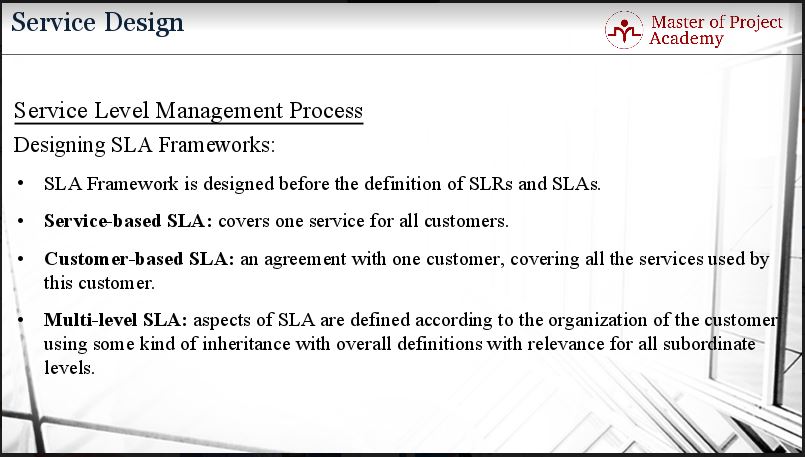If you’ve enrolled in ITIL Training you won’t have to ask what a service level agreement (SLA) is. However, if you haven’t done an ITIL online course yet, we’ll help you out. A service level agreement SLA is an agreement between an IT Service provider and a customer.
For instance, you are a customer of a bank and the bank provides services to you. A service level agreement between you and the bank describes the services provided and the service levels at which they will be provided. For example, the bank will allow you to withdraw money from an ATM and the transaction will last no longer than 10 seconds. That is an example of a service level agreement and it is part of service level management.
There are three types of SLAs that can be documented. Before defining ITIL service level requirements and agreeing on the service levels through SLA, the most appropriate SLA structure must be designed. Depending on the services that will be provided to a customer or business, an SLA structure is designed that fits the purpose. Service level agreements are usually signed during the ITIL service design stage of the ITIL lifecycle.
- Check out our new course offers and learn Power BI:
Service Level SLA
The first type of service level agreement structure is the service-based SLA. A service-based SLA covers one service for all customers. Let’s consider that the IT service provider provides customer query service for many customers. In a service-based service level agreement, the service level of the customer query service will be the same for all customers that will be using this service. For instance, if the finance department and the human resources department are two customers who will be using this service, the same SLA will be valid between the IT service provider and these two departments since it is a service-based SLA.

Customer-based SLA
The second type of service level agreement structure is the customer-based SLA. A customer-based SLA is a contract with one customer, covering all the services used by this customer. Let’s consider the relationship between you and your telecom operator. You use the voice services, SMS services, data services, and several other services of the telecom operator. For all these services, you have only one contract between you and the telecom operator. Similarly, if the IT service provider provides several services for the business and the customers, and if all the service levels are documented in one customer service level agreement for the provided services, it will be a customer-based SLA.
Multi-level SLA
The third and the last type of service level agreement is the multi-level SLA. In multi-level SLA, aspects of SLA are defined according to the organization of the customer using some kind of inheritance with overall definitions with relevance for all subordinate levels. This SLA focuses on the organization of the customer. All services and their interrelationships with subordinate services are used when defining the multi-level service level agreement structure.
Maintaining service level agreements are part of service level management. Every time a service changes, or the service level target of service changes, the service level agreement needs to be reviewed and revised. The new service level agreement needs to reflect the changes made to the service or the service level targets. Therefore, the management of service level agreements is an important part of ITIL continual service improvement.
Why it’s important to have an SLA
Without a service level agreement, it is not clear what will happen if one of the parties involved does not hold up to their end of the bargain. For example, let’s consider that a telecom provider’s service level target is to answer all help desk calls within 5 seconds, and the calls are only being answered within 5 minutes. They can easily say that they never promised that the calls will be answered within 5 seconds if there was no service level agreement in place. Having an SLA allows for transparency about what the service level targets are as well as what happens if the required targets are not met. With a service level agreement in place, both parties are protected.
The main components of an SLA
A service level agreement states what the two parties want to achieve with their agreement along with an outline of the responsibilities of each party including expected outputs with performance measures. A service level agreement usually has a duration period that is specified in the agreement. All the services that are included in the agreement are described and can also contain details regarding procedures for monitoring the service performance as well as problem-solving procedures.
How to set SLA metrics
Service level agreements include performance metrics by which the service provider’s performance of their services is measured. It can be difficult to correctly choose metrics that are fair to both parties. It’s important that the metrics are within the service provider’s control. If the service provider can’t control whether the metric performs within specification, then it is unfair to hold them accountable for the metric.
It also helps if the data for the metrics can be easily and accurately collected. If the data can be captured automatically, that is ideal. It’s better to have fewer accurately measured metrics than a lot of metrics that no one would have the time to analyze.
Finally, it is important to specify a baseline for the SLA metrics in the service level agreement. This baseline must be reasonable, but can be tightened up during a review of the SLA when more data on the metrics have been collected.

Service level agreements are the first step in creating a relationship between a service provider and a customer. By being clear about what is expected from each party, there can be transparency and trust on both sides. Regardless of which kind of service level agreement is signed, each party can now be held accountable to keep up their end of the bargain. Sometimes it is necessary to compromise if the service provider does not have the resources to comply with the customer’s requirements. In such a case, the customer may have to rethink their requirements and the service provider might have to invest in more resources. Such compromises establish a good working relationship between service provider and customer.
Review by: George Henderson

